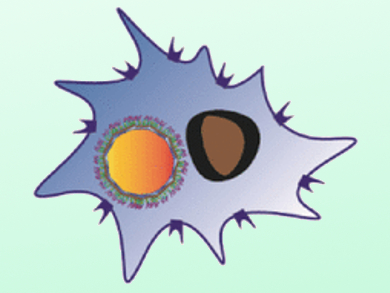Help against Fungal Infections
Fungal infections represent an increasing health crisis, especially for immune-deficient patients. American scientists report in the journal Angewandte Chemie that specific help could be provided by small-molecule immunotherapeutics with a novel mechanism of action.
The researchers have developed small bifunctional molecules that simultaneously bind both chitin, a specific feature of the fungal cell wall and a molecule not found in humans, and naturally occurring human antibodies and redirect the human immune system to eliminate fungal pathogens. The fungal cell wall is an attractive target for the development of new antifungal drugs because many fungal cell-wall components are not present in humans, enabling the exclusive targeting of fungal cells.
Small-Molecule Immunotherapeutics
To obtain bifunctional molecules, called Antibody-Recruiting Molecules targeting Fungi (ARM-F), David A. Spiegel, Yale University, New Haven, CT, USA, and colleagues have modified the key molecule calcofluor-white, a chitin-specific dye used to stain cell walls of fungi, and linked this molecule to a dinitrophenyl (DNP) group. DNP is recognized by human anti-DNP antibodies, which are naturally present in the bloodstream. The resulting chitin, ARM-F, and anti-DNP-antibody complex is immunogenic and can stimulate effector immune cells, which then cause the destruction of chitin-expressing fungal cells through phagocytosis (pictured).
The team was able to show that ARM-F can bind the model fungal pathogen Candida albicans and recruit anti-DNP antibodies in a dose-dependent manner, without compromising the viability of the cells. They went on to demonstrate that ARM-F has synergistic effects with the antifungal agent caspofungin—a type of echinocandin. Echinocandin-resistant fungi exhibit increased chitin production in the fungal cell wall; thus, the efficacy of ARM-F was even more pronounced when combined with caspofungin. In vitro studies confirmed that the phagocytosis of fungal cells by human effector immune cells was increased in the presence of ARM-F.
The specific chitin-targeting mechanism of ARM-F holds promise for fighting echinocandin-resistant fungi, as well as a number of pathogenic fungi. These mechanistically novel small molecules have the potential of serving as an innovative platform for antifungal drug development, both as a single agent or for use in combination with existing antifungal strategies.
- Neutralization of Pathogenic Fungi with Small-Molecule Immunotherapeutics,
Egor Chirkin, Viswanathan Muthusamy, Paul Mann, Terry Roemer, Philippe G. Nantermet, David A. Spiegel,
Angew. Chem. Int. Ed. 2017.
DOI: 10.1002/anie.201707536




